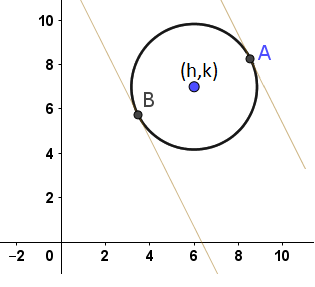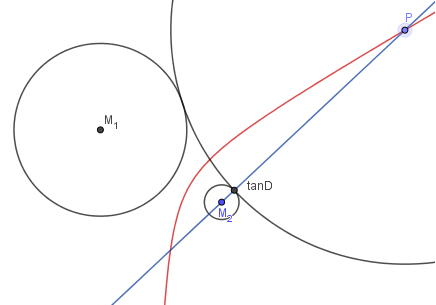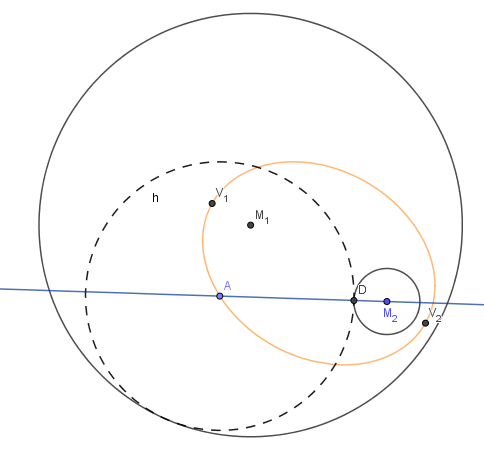Tangent to a Circle from a Line Slope
If we have the equation of a circle and want to find the points on the circle that have a given slope, we can do that by just solving two simultaneous equations. This is the same as saying we are given a line slope and want to know the equation of the line that is tangent to the circle. Let the circle be given by $$(x-h)^{2}+(y-k)^{2}=r^{2} \tag{1} \label{1}$$ The center of the circle is $(h,k)$. Let the given line slope be $m$. If one of the tangent points is $(A_{x},A_{y}),$ then we have an equation for it. $$\left(A_{x}-h\right)^{2}+\left(A_{y}-k\right)^{2}=r^{2}$$ There is a line perpendicular to the tangents that goes through the two tangent points and the center of the circle. Its slope is $-1/m$. Using the points on that line, we can get another equation. $$\frac{\Delta y}{\Delta x}=\frac{A_{y}-k}{A_{x}-h}=-\frac{1}{m}$$ Solve the two equations simultaneously for unknown points in $(A_{x},A_{y})$, and notice that we get enough solutions for both tangent points. Below we refer to the second tangent point as $B$. $$A_{x}=\frac{\left(m^{2}+1\right)\;h-m\;\sqrt{m^{2}+1}\;r}{m^{2}+1}$$ $$A_{y}=\frac{\left(m^{2}+1\right)\;k+\sqrt{m^{2}+1}\;r}{m^{2}+1}$$ $$B_{x}=\frac{\left(m^{2}+1\right)\;h+m\;\sqrt{m^{2}+1}\;r}{m^{2}+1}$$ $$B_{y}=\frac{\left(m^{2}+1\right)\;k-\sqrt{m^{2}+1}\;r}{m^{2}+1}$$
Answer: Name the two tangent poins $A$ and $B$. Using just point A, we get two equations: $$(A_{x}-6)^{2}+(A_{y}-7)^{2}=8$$ $$\frac{A_{y}-7}{A_{x}-6}=\frac{-1}{-2}$$ and their solutions are $$\left(\begin{array}{c} \left(A_{x},A_{y}\right)\\ \left(B_{x},B_{y}\right) \end{array}\right)=\,\left(\begin{array}{rr} \frac{4\;\sqrt{10}+30}{5} & \frac{2\;\sqrt{10}+35}{5}\\ \frac{-4\;\sqrt{10}+30}{5} & \frac{-2\;\sqrt{10}+35}{5} \end{array}\right)=\left(\begin{array}{cc} 8.53 & 8.26\\ 3.47 & 5.74 \end{array}\right)$$

Uniform Size Tangent Circles
If circles, all of the same radius are tangent to one another, then a bounding circle of smallest size can easily be constructed around them. Indeed, for the method to be shown, it isn't actually necessary that the interior circles be tangent to each other, only that they be of uniform radius.

Tangent to Two Circles
This section could be subtitled “Locus of points equidistant from two circles”. Suppose that we have two circles and we want to construct a third circle that is kissing (tangent to) both. How might we do that?

Case 1. The two circles do not overlap. In figure 1, circle $M_1$ has center $M_{1}$ with radius $r_{1}$ and circle $M_{2}$ has center $M_{2}$ with radius $r_{2}$. If we equate the functions of the two circles, we will get an implicit function that is one branch of a hyperbola. It is actually the branch that is closest to the smaller circle. Changing the sign of both radii will get the other branch. $$circle_{1}(x,y)=\sqrt{\left(x-M_{1x}\right)^{2}+\left(y-M_{1y}\right)^{2}}-r_{1}$$ $$circle_{2}(x,y)=\sqrt{\left(x-M_{2x}\right)^{2}+\left(y-M_{2y}\right)^{2}}-r_{2}$$ $$\sqrt{\left(x-M_{1x}\right)^{2}+\left(y-M_{1y}\right)^{2}}-r_{1}=\sqrt{\left(x-M_{2x}\right)^{2}+\left(y-M_{2y}\right)^{2}}-r_{2}$$ A nice feature of writing the hyperbola equations in this form is that due to the roots, they are already oriented (rotated) correctly. The hyperbola branch represents a locus of points that are equidistant from both circles. Therefore, our center point can be anywhere on the hyperbolic branch.
To find the tangent points, first pick a new circle center (name it $P$) and write a line equation from $M_{1}$ to $P$ and another from $M_{2}$ to $P$. Intersect the respective lines and circles to the tangent points.
In the applet below you can use a mouse to move around the points and see that the circle about $P$ is always tangent to $M_1$ and $M_2$ so long as the circles are completely separate from one another.

Case 2.The two circles are such that the smaller one is completely inside of the larger one. In figure 2, the larger circle has center $M_{1}$ with radius $r_{1}$ and the smaller circle has center $M_{2}$ with radius $r_{2}$.
If we were to equate the two circles, we would get the equation of a hyperbola again and it would not be of much help. In this case, we need to change the sign of one of the circles and then equate them to get an equation of an ellipse. $$circle_{1}(x,y)=\sqrt{\left(x-M_{1x}\right)^{2}+\left(y-M_{1y}\right)^{2}}-r_{1}$$ $$circle_{2}(x,y)=\sqrt{\left(x-M_{2x}\right)^{2}+\left(y-M_{2y}\right)^{2}}-r_{2}$$ $$-\left[\sqrt{\left(x-M_{1x}\right)^{2}+\left(y-M_{1y}\right)^{2}}-r_{1}\right]=\sqrt{\left(x-M_{2x}\right)^{2}+\left(y-M_{2y}\right)^{2}}-r_{2}$$ As before, the roots assure that the ellipse is already rotated correctly. To find the tangent points, first pick an new circle center (name it $A$). it can be anywhere on the ellipse. Write a line equation from $M_{1}$ to $A$ and another from $M_{2}$ to $A$. Intersect the respective lines and circles to the tangent points.
Case 3. The two circles intersect. In this case, the locus of points that are equidistant from the two circles are represented by both the ellipse and the hyperbola. Consequently, we would do both case 1 and case 2. Although no Applet is presented for this, you can use either Applet above to drag the circles into an intersection and see the consequence of the individual cases.